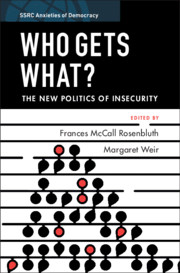Book contents
- Who Gets What?
- SSRC Anxieties of Democracy
- Sponsored by the Social Science Research Council
- Who Gets What?
- Copyright page
- Contents
- Figures
- Tables
- Author Biographies
- Acknowledgments
- 1 Introduction
- Part I People
- Part II Places
- 6 Keeping Your Enemies Close
- 7 America’s Unequal Metropolitan Geography
- 8 Redistribution and the Politics of Spatial Inequality in America
- Part III Politics
- Index
- References
7 - America’s Unequal Metropolitan Geography
Segregation and the Spatial Concentration of Affluence and Poverty
from Part II - Places
Published online by Cambridge University Press: 20 August 2021
- Who Gets What?
- SSRC Anxieties of Democracy
- Sponsored by the Social Science Research Council
- Who Gets What?
- Copyright page
- Contents
- Figures
- Tables
- Author Biographies
- Acknowledgments
- 1 Introduction
- Part I People
- Part II Places
- 6 Keeping Your Enemies Close
- 7 America’s Unequal Metropolitan Geography
- 8 Redistribution and the Politics of Spatial Inequality in America
- Part III Politics
- Index
- References
Summary
This chapter examines temporal trends and geographic patterns of class segregation and class isolation using a consistently defined dataset of 287 metropolitan areas for 1970-2010. We document changes in class distribution and class segregation over time and demonstrate the increasing spatial isolation of the affluent within neighborhoods of metropolitan areas that are embedded in the global economy and the spatial isolation of the poor in neighborhoods in those bypassed by globalization. The residential isolation of affluent whites and Asians and their spatial segregation from the poor are intensified by the persistence of racial segregation, which simultaneously exacerbates the concentration of poverty experienced by African Americans and Hispanics while increasing the concentration of affluence for whites and Asians. Our analysis suggests the current polarization of politics and well-being in the United States are grounded in America’s entrenched ecology of racial and class segregation.
- Type
- Chapter
- Information
- Who Gets What?The New Politics of Insecurity, pp. 161 - 187Publisher: Cambridge University PressPrint publication year: 2021
References
- 2
- Cited by

